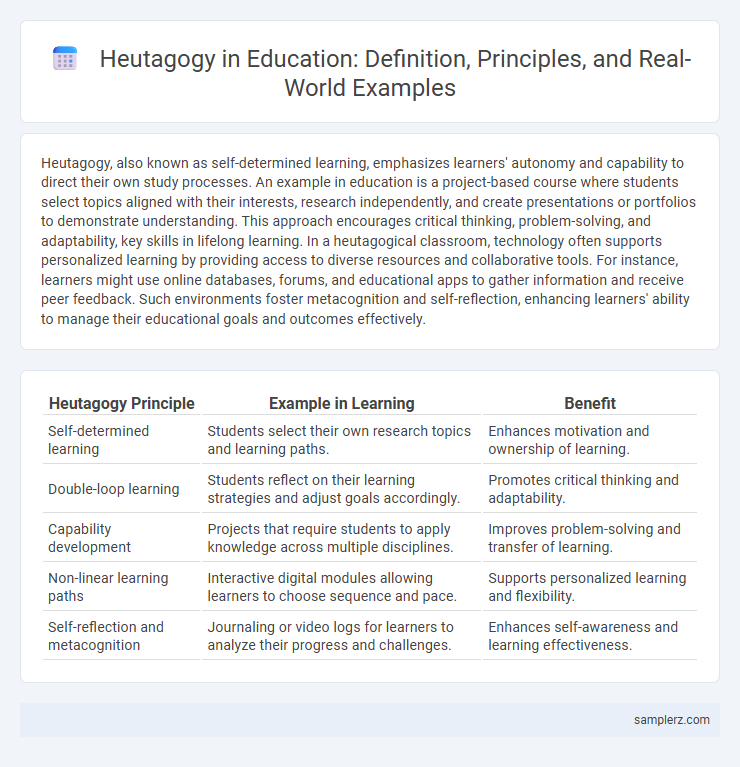Heutagogy, also known as self-determined learning, emphasizes learners' autonomy and capability to direct their own study processes. An example in education is a project-based course where students select topics aligned with their interests, research independently, and create presentations or portfolios to demonstrate understanding. This approach encourages critical thinking, problem-solving, and adaptability, key skills in lifelong learning. In a heutagogical classroom, technology often supports personalized learning by providing access to diverse resources and collaborative tools. For instance, learners might use online databases, forums, and educational apps to gather information and receive peer feedback. Such environments foster metacognition and self-reflection, enhancing learners' ability to manage their educational goals and outcomes effectively.
Table of Comparison
| Heutagogy Principle | Example in Learning | Benefit |
|---|---|---|
| Self-determined learning | Students select their own research topics and learning paths. | Enhances motivation and ownership of learning. |
| Double-loop learning | Students reflect on their learning strategies and adjust goals accordingly. | Promotes critical thinking and adaptability. |
| Capability development | Projects that require students to apply knowledge across multiple disciplines. | Improves problem-solving and transfer of learning. |
| Non-linear learning paths | Interactive digital modules allowing learners to choose sequence and pace. | Supports personalized learning and flexibility. |
| Self-reflection and metacognition | Journaling or video logs for learners to analyze their progress and challenges. | Enhances self-awareness and learning effectiveness. |
Introduction to Heutagogy in Modern Education
Heutagogy in modern education emphasizes learner autonomy and self-determined learning, allowing students to design their own learning pathways and actively engage with content. For example, a course on digital marketing might enable learners to select projects based on personal interests, conduct independent research, and reflect on their skill development. This approach fosters critical thinking, adaptability, and lifelong learning skills essential for contemporary educational environments.
Key Principles of Heutagogical Learning
Heutagogical learning emphasizes learner autonomy, where students actively co-design their learning paths and reflect critically on their progress. Key principles include self-determined learning, capability development beyond competencies, and double-loop learning, which fosters deeper understanding through questioning underlying assumptions. This learner-centered approach enhances adaptability and lifelong learning skills essential for evolving educational environments.
Real-World Applications of Heutagogy in Classrooms
In heutagogy, students take ownership of their learning by identifying real-world problems and designing projects that address community needs, such as creating sustainable garden solutions or developing local history documentaries. This learner-centered approach promotes critical thinking and self-reflection, enhancing adaptability and lifelong learning skills essential for modern careers. Technology integration, like using digital portfolios and online collaboration tools, further supports personalized learning paths and authentic assessment in heutagogical classrooms.
Case Study: Self-Determined Learning Projects
Self-determined learning projects in heutagogy empower students to design and manage their own educational goals, fostering autonomy and intrinsic motivation. Case studies highlight learners selecting topics like environmental sustainability, conducting research, and reflecting on outcomes without direct instructor control. These projects demonstrate enhanced critical thinking, problem-solving skills, and personalized knowledge acquisition in education.
Heutagogy in Online and Blended Learning Environments
Heutagogy in online and blended learning environments empowers learners to take control of their educational journey by promoting self-determined learning and critical reflection. Digital platforms facilitate access to diverse resources and collaborative tools, enabling learners to customize content according to their needs and interests. This approach enhances learner autonomy, engagement, and adaptability, crucial skills for navigating complex, technology-driven educational settings.
Heutagogical Approaches in Higher Education
Heutagogical approaches in higher education emphasize learner autonomy by encouraging students to design personalized learning pathways that foster critical thinking and self-reflection. For example, project-based learning allows learners to identify their own objectives, access diverse resources, and evaluate their progress independently, enhancing metacognitive skills. This method supports lifelong learning by adapting to individual needs and rapidly evolving knowledge landscapes.
Teacher Roles in Facilitating Heutagogy
Teachers in heutagogy act as facilitators by guiding learners to take ownership of their educational journey through self-determined learning strategies. They create flexible learning environments that encourage critical reflection, problem-solving, and the development of metacognitive skills. This shift from traditional instruction to learner-centered facilitation promotes autonomy, adaptability, and lifelong learning competencies.
Technology Tools Supporting Heutagogy
Digital platforms such as Khan Academy and Coursera empower learners to self-direct their education through personalized content and pace control, exemplifying heutagogical principles. Collaborative tools like Google Workspace facilitate autonomous knowledge construction and peer interaction, enhancing metacognitive skills essential in heutagogy. Adaptive learning systems, powered by AI, continuously analyze learner data to tailor educational experiences, supporting the development of capability and lifelong learning autonomy.
Benefits and Challenges of Heutagogy
Heutagogy empowers learners to take control of their own education, fostering critical thinking, self-reflection, and lifelong learning skills essential for adapting in dynamic environments. Benefits include enhanced learner autonomy, increased motivation, and personalized learning experiences that cater to individual needs and interests. Challenges involve the requirement for high learner self-discipline, potential difficulties in assessing progress, and the need for facilitators to shift from traditional teaching roles to supportive mentors.
Future Directions for Heutagogy in Education
Future directions for heutagogy in education emphasize personalized, self-determined learning enabled by advanced digital tools and artificial intelligence. Emerging technologies facilitate adaptive learning environments where students co-create curricula and assess their progress autonomously. This approach aligns with 21st-century skills development, promoting critical thinking, creativity, and lifelong learning competencies essential for future workforce demands.

example of heutagogy in learning Infographic
 samplerz.com
samplerz.com